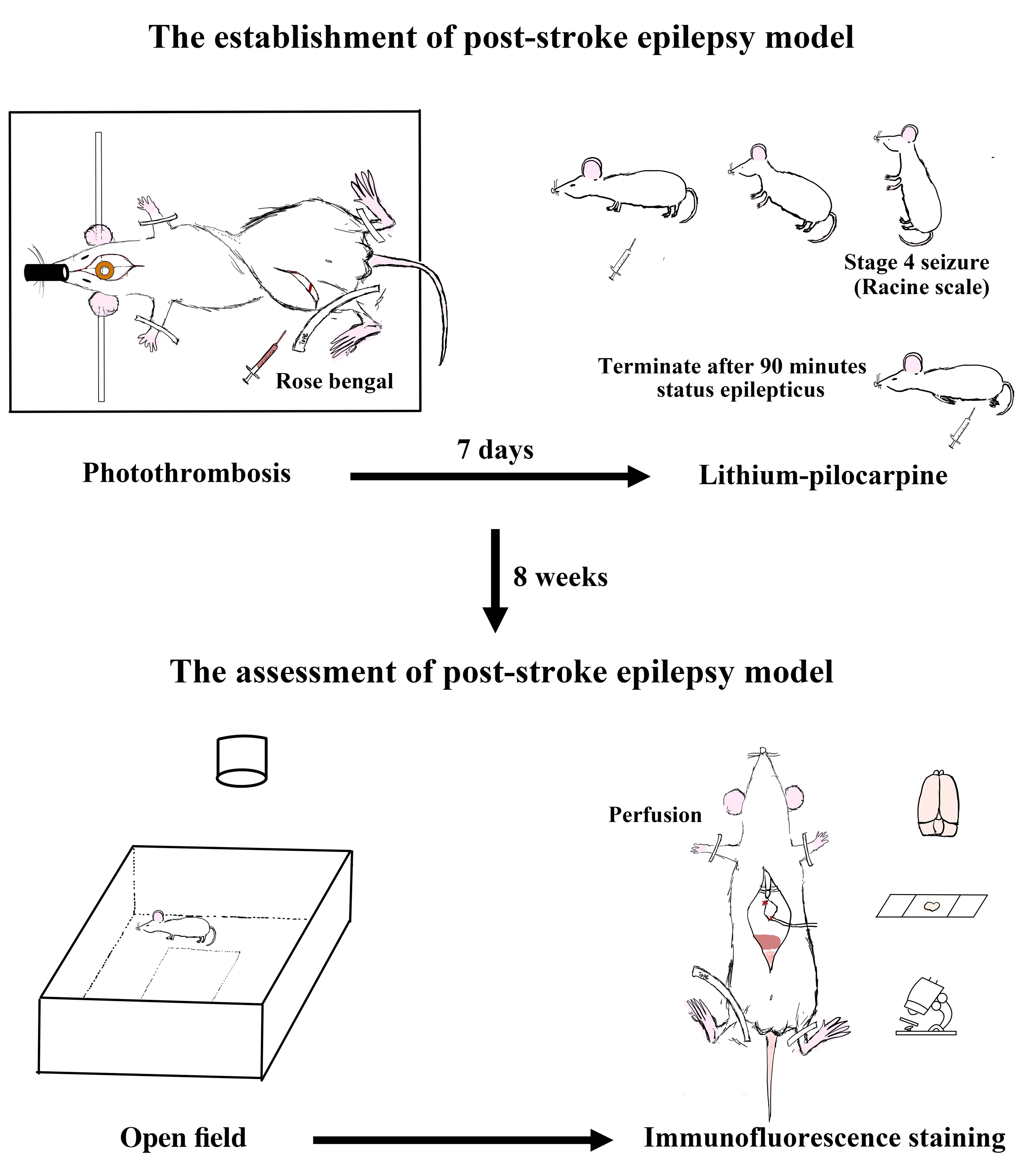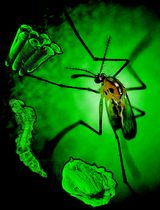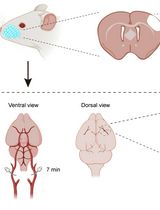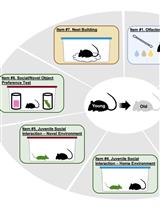- EN - English
- CN - 中文
A Novel Composite Method of Post-stroke Epilepsy Induction
脑卒中后癫痫的一种新型复合诱导方法
发布: 2025年07月20日第15卷第14期 DOI: 10.21769/BioProtoc.5387 浏览次数: 1284
评审: Mayank GautamAnonymous reviewer(s)
Abstract
The global burden of stroke has increased in the past several decades, and post-stroke epilepsy (PSE) is a common complication. Contrasted with the advancement in knowledge of stroke pathophysiology, the exact pathogenesis of PSE is unclear. Various animal stroke models have been utilized to investigate the underlying mechanisms of PSE, but the success rate of PSE induction is low. To address this limitation, a novel PSE model was established in the rat by inducing status epilepticus using lithium-pilocarpine one week after photothrombotic stroke. Successful indication of status epilepticus and mortality rate at three days after status epilepticus were the main measurements. Potential usefulness of this model was also illustrated by preliminary results on locomotor activity, exploratory behavior, and anxiety level evaluated using the open-field test, as well as mossy fiber sprouting (MFS) in the hippocampal dentate granule cells using Zinc transporter 3 immunofluorescence staining at 8 weeks after PSE induction. This novel composite method of PSE induction may facilitate future studies on the pathogenesis and treatment of PSE.
Key features
• We developed a new PSE model in the rat by combining the photothrombotic model of stroke and lithium-pilocarpine (LIP) model of temporal lobe epilepsy (TLE).
• In our novel rat PSE model, 94% of rats achieved status epilepticus, and mortality rate at 3 days was 25%.
• The PSE rats appeared to have a decreased anxiety level on the open-field test and MFS in the hippocampal dentate granule cells.
Keywords: Post-stroke epilepsy (脑卒中后癫痫)Graphical overview

A novel composite method of post-stroke epilepsy (PSE) induction. The PSE model was established in the rat by inducing status epilepticus using lithium-pilocarpine one week after a photothrombotic stroke. Successful indication of status epilepticus and mortality rate at three days were the main measurements. Potential usefulness of this model was also illustrated by preliminary results on locomotor activity, exploratory behavior, and anxiety level evaluated using the open-field test, as well as mossy fiber sprouting (MFS) in the hippocampal dentate granule cells using Zinc transporter 3 immunofluorescence staining at 8 weeks after PSE induction.
Background
Both stroke and epilepsy are common. Their burdens are rising, especially with the aging of the global population. Epilepsy is a common complication of stroke, referred to as post-stroke epilepsy (PSE). Various animal stroke models have been developed to advance our knowledge of stroke pathophysiology and treatment. In the photothrombotic stroke model, a highly consistent and reproducible infarct is achieved by illuminating the brain after the injection of Rose Bengal to produce cortical thrombosis [1]. Epileptic seizures after photothrombotic stroke with small or larger infarct size over various cortical regions were monitored with video and EEG recordings in F344 and Sprague-Dawley (SD) rats of different ages [2]. PSE was recorded in post-mature rats 2 months after larger photothrombotic infarcts in the frontoparietal cortex extending to the cortical-subcortical interface. Small and parietal cortical lesions were relatively ineffective in producing PSE. In another study using SD rats, video and EEG recordings were conducted at 2, 4, 6, 8, and 10 months after photothrombosis [3]. Only 18% of rats developed PSE. In addition, epileptic rats had bilateral mossy fiber sprouting (MFS) in hippocampal dentate granule cells. Although photothrombotic stroke and other stroke models per se can be used to investigate the underlying pathogenic mechanisms of PSE, a low PSE rate is a major limitation. Furthermore, the PSE occurrence is unpredictable and delayed. The lithium-pilocarpine (LIP) model has been widely used to study temporal lobe epilepsy (TLE) in rodents. Strokes in the temporal lobe are associated with a high risk of post-stroke TLE. Here, we set up a new rat PSE model by combining the photothrombotic model of stroke and the LIP model of TLE, with successful indication of status epilepticus and mortality rate at three days after status epilepticus as the main measurements. Preliminary results on locomotor activity, exploratory behavior, and anxiety level evaluated using the open-field test, as well as MFS in the hippocampal dentate granule cells using Zinc transporter 3 immunofluorescence staining at 8 weeks after PSE induction, were shown to illustrate the potential usefulness of this model.
Materials and reagents
Reagents
1. Skin prepping antiseptic solution (Povidone Iodine) (3M, catalog number: IA420100272)
2. Rose Bengal dye (Sigma-Aldrich, catalog number: 632-69-9, stable at room temperature)
3. Scopolamine methyl bromide (Tokyo Chemical Industry, catalog number: 155-41-9, stable for 5 years at room temperature)
4. Lithium chloride (Sigma-Aldrich, catalog number: 7447-41-8, stable for 3 years at room temperature)
5. Pilocarpine hydrochloride (Sigma-Aldrich, catalog number: 54-71-7, stable for 5 years at room temperature)
6. Pamlin solution (Diazepam) (Ceva Animal Health, catalog number: 544-18, store at room temperature)
7. Sodium phosphate dibasic (Na2HPO4) (Sigma-Aldrich, catalog number: 7558-79-4, stable for 3 years at room temperature)
8. Sodium phosphate monobasic (NaH2PO4) (Sigma-Aldrich, catalog number: 7558-80-7, stable for 3 years at room temperature)
9. Sodium chloride (NaCl) (Sigma-Aldrich, catalog number: 7647-14-5, stable for 3 years at room temperature)
10. Sodium hydroxide solution (NaOH) (Sigma-Aldrich, catalog number: 1310-73-2, store at room temperature)
11. Hydrochloric acid solution (HCl) (Sigma-Aldrich, catalog number: 7647-01-0, store at room temperature)
12. Paraformaldehyde (Sigma-Aldrich, catalog number: 30525-89-4, store at room temperature)
13. Sucrose (Sigma-Aldrich, catalog number: 57-50-1, store at room temperature)
14. Sodium citrate (Sigma-Aldrich, catalog number: 6132-04-3, stable for 5 years at room temperature)
15. Tween 20 (Sigma-Aldrich, catalog number: 9005-64-5, store at room temperature)
16. Triton X-100 (Sigma-Aldrich, catalog number: 9036-19-5, stable for 2 years at room temperature)
17. Rabbit anti-ZnT3 (Synaptic system, catalog number: 197002, store at -20 °C in the dark)
18. Normal goat serum (Thermo Fisher Scientific, catalog number: PCN5000, store at -20 °C)
19. Alexa Fluor® 568 goat anti-rabbit (Thermo Fisher Scientific, catalog number: A11011, stable for 2 years at 4 °C, store in the dark)
20. DietGel 76A [Clear H2O, catalog number: 72-07-5022; ingredients: purified water, molasses, animal protein (milk), vegetable oil, food acids, cane sugar, mineral mix, hydrocolloids, citrus fiber, vitamin mix, electrolyte blend, L-methionine]
21. O.C.T. Compound (Tissue-Tek, catalog number: 4583)
Solutions
1. 0.9% sterile saline solution (see Recipes)
2. Rose Bengal solution (see Recipes)
3. Scopolamine stock solution (see Recipes)
4. Scopolamine working solution (see Recipes)
5. Lithium working solution (see Recipes)
6. Pilocarpine working solution (see Recipes)
7. 4% formalin solution (see Recipes)
8. 10% sucrose solution (see Recipes)
9. 30% sucrose solution (see Recipes)
10. 10 mM citrate buffer (see Recipes)
Recipes
1. 0.9% sterile saline solution
| Reagent | Final concentration | Quantity or Volume |
|---|---|---|
| NaCl | 9 g/L | 4.5 g |
| Double-distilled water (DDW) | n/a | quantity sufficient (Q.S.) 500 mL |
| Total | n/a | 500 mL |
2. Rose Bengal solution
| Reagent | Final concentration | Quantity or Volume |
|---|---|---|
| Rose Bengal | 10 mg/mL | 50 mg |
| 0.9% sterile saline solution | n/a | Q.S. 5 mL |
| Total | n/a | 5 mL |
Caution: Stable for 4 h at 4 °C, protected from light; 5 mL adequate for 5 rats (around 300 g).
3. Scopolamine stock solution
| Reagent | Final concentration | Quantity or Volume |
|---|---|---|
| Scopolamine | 10 mg/mL | 100 mg |
| 0.9% sterile saline solution | n/a | Q.S. 10 mL |
| Total | n/a | 10 mL |
Caution: Stable for 1 week at 4 °C, protected from light.
4. Scopolamine working solution
| Reagent | Final concentration | Quantity or Volume |
|---|---|---|
| Scopolamine stock solution | n/a | 1 mL |
| 0.9% sterile saline solution | n/a | 9 mL |
| Total | n/a | 10 mL |
Caution: Generally safe, use gloves and eye protection; freshly prepared, protected from light; 10 mL adequate for 30 rats (around 300 g).
5. Lithium working solution
| Reagent | Final concentration | Quantity or Volume |
|---|---|---|
| Lithium chloride | 3 mEq/mL | 30 mEq |
| 0.9% sterile saline solution | n/a | Q.S. 10 mL |
| Total | n/a | 10 mL |
Caution: Generally safe, use gloves and eye protection; freshly prepared; 10 mL adequate for 15 rats (around 300 g).
6. Pilocarpine working solution
| Reagent | Final concentration | Quantity or Volume |
|---|---|---|
| Pilocarpine | 30 g/L | 0.3 g |
| 0.9% sterile saline solution | n/a | Q.S. 10 mL |
| Total | n/a | 10 mL |
Caution: Generally safe, use gloves and eye protection; freshly prepared; 10 mL adequate for 15 rats (around 300 g).
7. 4% formalin solution
| Reagent | Final concentration | Quantity or Volume |
|---|---|---|
| Paraformaldehyde | 40 g/L | 80 g |
| NaOH (5 M) | n/a | 0.3 mL |
| Na2HPO4 | 0.2 M | 22.71 g |
| NaH2PO4 | 0.2 M | 4.80 g |
| DDW | n/a | Q.S. 2 L |
| Total (pH 7.4) | n/a | 2 L |
Caution: Stable for 1 month at 4 °C.
Hazardous: The preparation of formalin solution should be performed in the ventilated fume hood.
8. 10% sucrose solution
| Reagent | Final concentration | Quantity or Volume |
|---|---|---|
| Sucrose | 300 g/L | 15 g |
| DDW | n/a | Q.S. 50 mL |
| Total (pH 7.4) | n/a | 50 mL |
Caution: Stable for 2 weeks at 4 °C.
9. 30% sucrose solution
| Reagent | Final concentration | Quantity or Volume |
|---|---|---|
| Sucrose | 300 g/L | 15 g |
| DDW | n/a | Q.S. 50 mL |
| Total (pH 7.4) | n/a | 50 mL |
Caution: Stable for 2 weeks at 4 °C.
10. 10 mM citrate buffer
| Reagent | Final concentration | Quantity or Volume |
|---|---|---|
| Sodium citrate | 2.5 mM | n/a |
| Tween 20 | n/a | 1 mL |
| HCl (1 N) | n/a | n/a |
| DDW | n/a | Q.S. 200 mL |
| Total (pH 6.0) | n/a | 200 mL |
Caution: Stable for 3 months at room temperature.
Laboratory supplies
1. Masks (Medicom, catalog number: 206415)
2. Gloves (Medicom, catalog number: OPXL-BIO)
3. 1 mL syringe (Terumo, catalog number: 22290018)
4. 27 G × 1/2” needle (Terumo, catalog number: NN2713R)
5. Blunt 15 G Needle for transcardiac perfusion (Strategic Applications, catalog number: NC0604239)
6. Superfrost Plus slides (Epredia, catalog number: 22-042-941)
7. Heating pad with a rectal thermometer (Stoelting, catalog number: 50300)
8. Orion Pro Star PH211 pH/ORP bench meter (Thermo Fisher Scientific, catalog number: PSTAR2119)
Equipment
1. CLS150 H-LED cold light source (Leica Biosystems, model: CLS150)
2. Compact stereotaxic frame (Harvard Apparatus, model: A0801)
3. Digital USB 2.0 CMOS camera and Lens Vari-focal 2.8–12 mm (Stoelting, model: 60516)
4. Cryostat (Leica Biosystems, model: CM1850)
5. Microscope (Nikon, model: Nikon ECLIPSE Ni)
6. Ventilated fume hood (Dynaflow, model: 2000GRP)
7. Video-tracking system, ANY-maze (Stoelting Co., model: 60000)
Software and datasets
1. ImageJ software (NIH, ImageJ Ver.1.36 b, 03/20/2012)
2. Prism (GraphPad Version 9.5.1, 02/07/2023)
Procedure
文章信息
稿件历史记录
提交日期: Apr 19, 2025
接收日期: Jun 12, 2025
在线发布日期: Jul 3, 2025
出版日期: Jul 20, 2025
版权信息
© 2025 The Author(s); This is an open access article under the CC BY-NC license (https://creativecommons.org/licenses/by-nc/4.0/).
如何引用
Guo, Y. and Cheung, R. T. F. (2025). A Novel Composite Method of Post-stroke Epilepsy Induction. Bio-protocol 15(14): e5387. DOI: 10.21769/BioProtoc.5387.
分类
神经科学 > 神经系统疾病 > 脑卒中
神经科学 > 行为神经科学 > 实验动物模型
神经科学 > 神经解剖学和神经环路 > 动物模型
您对这篇实验方法有问题吗?
在此处发布您的问题,我们将邀请本文作者来回答。同时,我们会将您的问题发布到Bio-protocol Exchange,以便寻求社区成员的帮助。
提问指南
+ 问题描述
写下详细的问题描述,包括所有有助于他人回答您问题的信息(例如实验过程、条件和相关图像等)。
Share
Bluesky
X
Copy link











